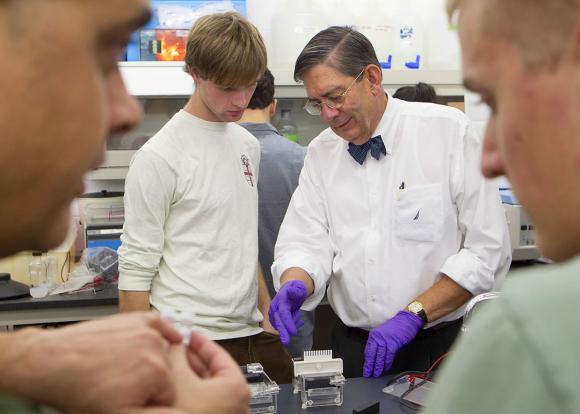PROVIDENCE, R.I. [Brown University] — The Association of American Universities (AAU) has chosen Brown University as a project site for an initiative to improve undergraduate education in science, technology, engineering, and mathematics (STEM) fields. Brown is one of eight AAU member institutions chosen to implement the initiative, which is designed to encourage STEM departments to adopt proven, evidence-based teaching practices and to provide faculty with the encouragement, training, and support to do so.
“Brown has a rich history of innovation in teaching and a collegial faculty willing to share their best ideas with each other,” said Katherine Bergeron, dean of the College at Brown. “Those strengths make Brown an ideal place to contribute to a national conversation about how to transform the teaching of college science.”
In addition to the project sites, AAU will create a STEM network in which it expects most or all of its 62 universities to participate. The network will enable faculty and administrators at AAU institutions to share best practices developed at Brown and at other project sites and campuses. The eight project sites were chosen from among 31 AAU universities that submitted concept papers. Papers were assessed on a number of criteria, including the degree of faculty engagement, institutional commitment, likelihood of sustained organizational change, and commitment to evaluation and assessment.
Brown’s three-year plan will start with a rethinking of STEM classes for first- and second-year students, starting with seven classes in physics, engineering and neuroscience. These classes represent crucial gateways to further study in the STEM disciplines for more than 800 Brown students who take them each year. Making sure students become engaged in these classes and learn effectively is a key to recruiting and retaining students in STEM fields. In the plan’s second and third years, practices developed in these classes will be expanded to other classes and disciplines.
“We have an increasing number of students coming in with an active interest in physical sciences and engineering,” Bergeron said. “We’re more concerned than ever about addressing learning gaps early so students can persist in these disciplines.”
Faculty and graduate students will work with Brown’s Sheridan Center for Teaching and Learning and the Brown Science Center to develop new curricula that emphasize hands-on learning, group problem solving, and opportunities for original research. Science faculty will also work with faculty in Brown’s math departments to identify gaps in students’ math skills that could discourage them from further study.
“We’re looking at basic math skills that students may have learned, but have a hard time applying to questions in science,” Bergeron said. “We want to make sure that knowledge is transferred across the disciplines, from math classrooms to science classrooms. Because of the collaborative spirit among our faculty and the open curriculum, Brown is uniquely positioned for that kind of cross-disciplinary effort.”
The AAU will support the initiative with $500,000 in seed money for each project site, and Brown will provide matching funds for its plan, bringing total funding at Brown to $1 million. The money will fund curriculum development grants to faculty members, support graduate students to help in modifying curricula, and provide for a rigorous assessment of the program’s effectiveness.
“The support structure is one of the most important aspects of the project,” said James Valles, professor and chair of Brown’s physics department. “We’re asking faculty to step outside their comfort zones and take some chances, and they need to know that they’re supported in doing so.” David Targan, associate dean of the College for science education and director of the Brown Science Center, says he’s pleased with the way faculty have responded to the project so far. Nearly 30 faculty members, including five department chairs, are now engaged in the project, with more expected to come on board as the project unfolds. “They’ve been very responsive,” Targan said. “They brought a number of innovative ideas to the conversation, things they had been thinking about before we ever approached them.”
“This is a conversation that started several years ago at Brown,” Bergeron said. “It’s part of a steady set of initiatives that we have undertaken, including the creation of the Science Center, School of Engineering, and School of Public Health. This grant comes at a critical time in our strategic planning, when we want to focus attention on something Brown has long been known for, which is innovation in education.”
The AAU initiative, which was launched in 2011, received a three-year, $4.7 million grant from The Leona M. and Harry B. Helmsley Charitable Trust last October that has enabled the association to develop the initiative framework and provide seed money to each project site. In addition to Brown, the other project sites are Michigan State University, Washington University in St. Louis, and the universities of Arizona, Colorado, North Carolina–Chapel Hill, Pennsylvania, and California–Davis.
Association of American Universities
The AAU is an association of 60 U.S. and two Canadian research universities organized to develop and implement effective national and institutional policies supporting research and scholarship, graduate and professional education, undergraduate education, and public service in research universities.
The Helmsley Trust
The Leona M. and Harry B. Helmsley Charitable Trust aspires to improve lives by supporting effective nonprofits in a variety of selected areas. Since 2008, when the trust began making grants, it has committed more than $900 million to a wide range of charitable organizations. Through its National Education Program, the trust views education as a lever to advance both American economic competitiveness and individual social mobility. In K-12, the trust focuses on ensuring that all students graduate high school prepared for college or careers by supporting teacher effectiveness and the implementation of high academic standards. In postsecondary education, the trust is primarily interested in increasing the number of science, technology, engineering and mathematics (STEM) graduates who can participate in high-growth sectors of the economy. The trust also focuses on policy levers that improve postsecondary completion, particularly for underrepresented populations. More information is available online at www.helmsleytrust.org.

